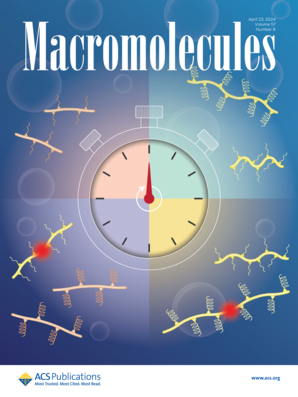Cyclic Poly(Thioester Amide)s via Ring-Opening Copolymerization of Aziridines and Phthalic Thioanhydride: Mechanistic Insights and Enhanced Properties for Sustainable Materials
IF 5.1
1区 化学
Q1 POLYMER SCIENCE
引用次数: 0
Abstract
Ring-opening copolymerization renders aziridines promising candidates for constructing N-containing polymers; however, producing polymers with predicted molar masses and defined sequence structures remains challenging. Here, we present a strategy for synthesizing poly(thioester amide)s (PTEAs) via ROCOP of N-alkyl aziridines and phthalic thioanhydride. Remarkably, perfectly alternating copolymerization was achieved by the synergistic catalysis of a phosphazene base and a protic initiator, delivering cyclic PTEAs with a molar mass of up to 188.4 kDa. Model reaction and chain extension experiments supported the rapid S-to-N acyl shift after aziridine ring-opening and spontaneous ring-closure upon applying an external stimulus. Notably, liquid-phase transmission electron microscopy confirmed the linear or cyclic topology before or after the postprocessing by spatially resolving the morphology of transient conformations. The in-chain thioester bonds endow polymers with enhanced thermal and optical properties compared to their poly(ester amide) counterparts, along with desirable degradability and biocompatibility, establishing a robust foundation for developing PTEAs as sustainable and functional biomedical materials.

通过开环共聚叠氮嘧啶和邻苯二甲酸硫酸酐的环聚硫酯酰胺:可持续材料的机理和增强性能
开环共聚使叠氮嘧啶成为构建含n聚合物的有希望的候选者;然而,生产具有预测摩尔质量和确定序列结构的聚合物仍然具有挑战性。本文提出了一种以n -烷基叠氮嘧啶和邻苯二甲酸乙酯为原料,采用ROCOP法合成聚硫酯酰胺(ptea)的方法。值得注意的是,通过磷腈碱和质子引发剂的协同催化,实现了完美的交替共聚,获得了摩尔质量高达188.4 kDa的环状ptea。模型反应和链扩展实验支持了氮化吡啶开环后s -到n酰基的快速转移和外部刺激下的自发闭环。值得注意的是,液相透射电镜通过空间解析瞬态构象的形态,证实了后处理前后的线性或循环拓扑结构。与聚(酯酰胺)相比,链内硫酯键赋予聚合物增强的热学和光学性能,以及理想的可降解性和生物相容性,为开发ptea作为可持续和功能性生物医学材料奠定了坚实的基础。
本文章由计算机程序翻译,如有差异,请以英文原文为准。
求助全文
约1分钟内获得全文
求助全文
来源期刊

Macromolecules
工程技术-高分子科学
CiteScore
9.30
自引率
16.40%
发文量
942
审稿时长
2 months
期刊介绍:
Macromolecules publishes original, fundamental, and impactful research on all aspects of polymer science. Topics of interest include synthesis (e.g., controlled polymerizations, polymerization catalysis, post polymerization modification, new monomer structures and polymer architectures, and polymerization mechanisms/kinetics analysis); phase behavior, thermodynamics, dynamic, and ordering/disordering phenomena (e.g., self-assembly, gelation, crystallization, solution/melt/solid-state characteristics); structure and properties (e.g., mechanical and rheological properties, surface/interfacial characteristics, electronic and transport properties); new state of the art characterization (e.g., spectroscopy, scattering, microscopy, rheology), simulation (e.g., Monte Carlo, molecular dynamics, multi-scale/coarse-grained modeling), and theoretical methods. Renewable/sustainable polymers, polymer networks, responsive polymers, electro-, magneto- and opto-active macromolecules, inorganic polymers, charge-transporting polymers (ion-containing, semiconducting, and conducting), nanostructured polymers, and polymer composites are also of interest. Typical papers published in Macromolecules showcase important and innovative concepts, experimental methods/observations, and theoretical/computational approaches that demonstrate a fundamental advance in the understanding of polymers.
 求助内容:
求助内容: 应助结果提醒方式:
应助结果提醒方式:


